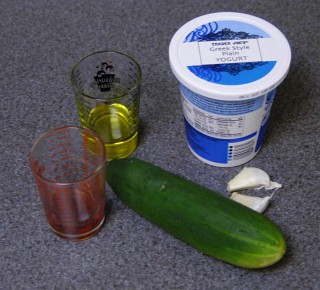 The ingredient ratios are pretty flexible with this recipe. Start with 1 pint (470 mL) Greek-style yogurt, 2 cloves garlic, 1 medium cucumber (we'll actually only use half a cucumber), 1 tablespoon (15 mL) red wine vinegar, and 1 tablespoon extra virgin olive oil. Anghelika says her grandmother kept telling her to make sure to remember the vinegar (as if it was the secret to her tsatsiki recipe).
The ingredient ratios are pretty flexible with this recipe. Start with 1 pint (470 mL) Greek-style yogurt, 2 cloves garlic, 1 medium cucumber (we'll actually only use half a cucumber), 1 tablespoon (15 mL) red wine vinegar, and 1 tablespoon extra virgin olive oil. Anghelika says her grandmother kept telling her to make sure to remember the vinegar (as if it was the secret to her tsatsiki recipe).The amount of garlic used in this recipe is up to the individual's taste. I suggest starting with the two cloves and adjusting to taste when you make tsatsiki in the future.
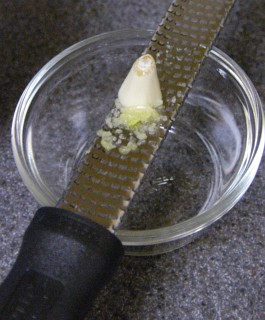 Peel the garlic cloves and cut off the woody ends. Pulverizing the cloves as best as you can. You can mince the garlic with a knife, rub it with the tings of a fork, run it through a garlic press, or use a zester (shown in the picture).
Peel the garlic cloves and cut off the woody ends. Pulverizing the cloves as best as you can. You can mince the garlic with a knife, rub it with the tings of a fork, run it through a garlic press, or use a zester (shown in the picture).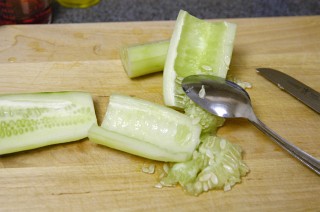 Peel the cucumber. Split the cucumber in half (cut crosswise) and then again along the length of the cucumber to expose the seeds. A teaspoon or similar implement can then be used to scrape out the seeds. Whenever I work with cucumbers, I always cut a little bit and taste it before I add it to a recipe. If a cucumber is old or not good quality, it can taste bitter instead of slightly sweet and refreshing. Using a cucumber like that can ruin a recipe pretty easily.
Peel the cucumber. Split the cucumber in half (cut crosswise) and then again along the length of the cucumber to expose the seeds. A teaspoon or similar implement can then be used to scrape out the seeds. Whenever I work with cucumbers, I always cut a little bit and taste it before I add it to a recipe. If a cucumber is old or not good quality, it can taste bitter instead of slightly sweet and refreshing. Using a cucumber like that can ruin a recipe pretty easily.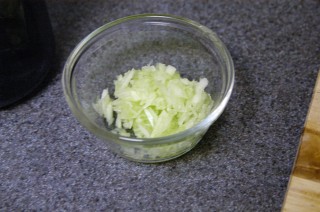 Cut up one half cucumber into small strips. You can use a coarse grater for this if you don't like fine knife work.
Cut up one half cucumber into small strips. You can use a coarse grater for this if you don't like fine knife work. Cucumbers contain a lot of water which we don't want to introduce to the Greek-style yogurt. (Greek-style yogurt or Bulgarian yogurt is strained to remove excess liquid, so it's a bit thicker than "standard" yogurt. It also tastes a bit different - the flavor seems closer to a really good sour cream than to plain Yoplait.) Take the chopped up cucumber and squeeze it. You can do this by placing it in a piece of cheesecloth and squeezing. My favorite method - squeeze it in your fist.
Cucumbers contain a lot of water which we don't want to introduce to the Greek-style yogurt. (Greek-style yogurt or Bulgarian yogurt is strained to remove excess liquid, so it's a bit thicker than "standard" yogurt. It also tastes a bit different - the flavor seems closer to a really good sour cream than to plain Yoplait.) Take the chopped up cucumber and squeeze it. You can do this by placing it in a piece of cheesecloth and squeezing. My favorite method - squeeze it in your fist.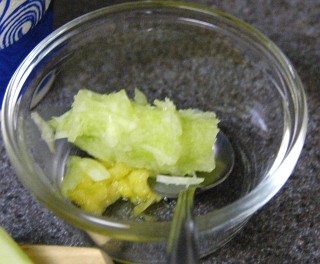 Add the drained cucumber to the garlic.
Add the drained cucumber to the garlic.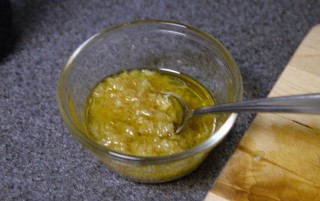 Mix the garlic, cucumber, olive oil, and vinegar together. Stir it around a little to separate the little garlic and cucumber pieces.
Mix the garlic, cucumber, olive oil, and vinegar together. Stir it around a little to separate the little garlic and cucumber pieces.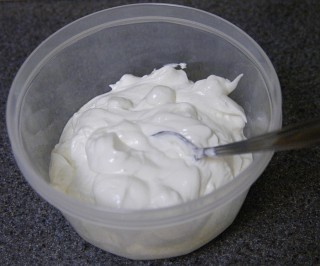 Put the yogurt in a container large enough to stir in the garlic and cucumber mixture without making a mess. I scooped the yogurt into a 1 quart container.
Put the yogurt in a container large enough to stir in the garlic and cucumber mixture without making a mess. I scooped the yogurt into a 1 quart container.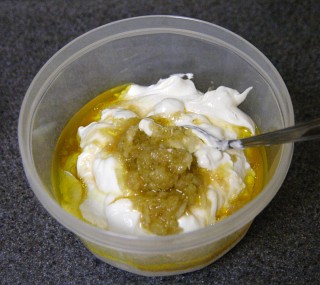 Add the garlic and cucumber mixture to the yogurt.
Add the garlic and cucumber mixture to the yogurt.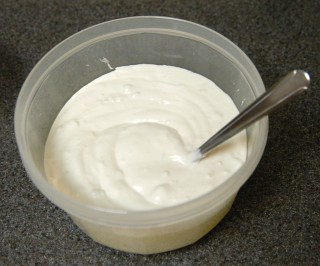 Stir until everything is evenly distributed in the yogurt. Stir in salt to taste. I found that 1/4 teaspoon table salt was a good amount.
Stir until everything is evenly distributed in the yogurt. Stir in salt to taste. I found that 1/4 teaspoon table salt was a good amount.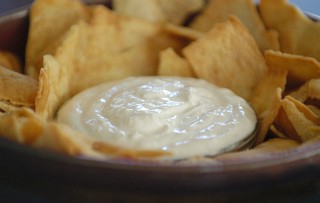 This step is really important - refrigerate for at least a day. Right after mixing the yogurt, the tsatsiki is a bit runny and somewhat flavorless (it just tastes like the yogurt). After refrigerating for a day, the garlic flavor permeates the thickened tsatsiki.
This step is really important - refrigerate for at least a day. Right after mixing the yogurt, the tsatsiki is a bit runny and somewhat flavorless (it just tastes like the yogurt). After refrigerating for a day, the garlic flavor permeates the thickened tsatsiki.Related Articles
| 1 pint (470 mL) Greek-style yogurt | mix | refrigerate 1 day | |||
| 2 cloves garlic | mince | mix | |||
| 1/2 medium cucumber | finely shred | drain | |||
| 1 Tbs. (15 mL) red wine vinegar | |||||
| 1 Tbs. (15 mL) extra virgin olive oil | |||||
| 1/4 tsp. (1.5 g) table salt | |||||
Related Articles

In the morning the yogurt is thick and all the liquid is in the bottom of the pitcher.
I made this last week and used lemon juice instead of the red wine vinegar, it turned out really well.
Sean
I think for this recipie you would add a 2 Tbs spoons.
If you don't have freash mint add 1 teaspoon of dried mint.
In the morning the yogurt is thick and all the liquid is in the bottom of the pitcher.
Sean
I use the same method to thicken yogurt (after the hint from Alton Brown--not an engineer, but cooks like one!); however, you only need about two hours to get a good and thick result. Also, FWIW, I use a woodskewer to support the cheesecloth and a plastic "bag clip" to secure it.
We are Greek and like many more. :D
Of course, everyone has to try some then.
I don't know any Grrek food, but guess what! It just suits our arab cuisine perfectly!
Tzatziki, after all, turns out to be an spiced "labanie" (dry yogurt).
I'll try it your way.
If you want to try it our way as well, we usually add olives and the spiced olive oil it comes in. Great to eat with pita bread.
Try the yogurt with tomatoes, olive oil and salt on a pita bread sandwich.
It's funny to see how food is an universal language, isn't it? :D
Daniel Montanha.
This is generally the Greek way: Greek Yogurt, (very good idea of Sean's to strain regular yogurt if Greek one not available), I don't peel the cucumber or remove the seeds but grate it on the thick side add salt and let it drain then squeeze the water out. (The cucumber peel makes it more digestible). Mix into the yogurt with the crushed garlic (some put more cloves some less). Add more salt if necessary, olive oil and a dash of vinegar. Adding chopped dill is optional but a very good addition.
Tzatziki is also delicious with fried zucchini, aubergines and is an excellent dip for raw vegetables, and anything you feel it tastes good with.
(I also use fresh mint & dill, it brings a nice subtle coolness to the dip)
:)
Kisses from beautifull Greece
Nikolas apo Korintho :)
"anithos" is "dill" :)
Stefanos
in honor of valentine's day one year, we used red vinegar and food dye to color the tzaziki and feta sauces pink. unfortunately, the gesture backfired as many customers mistook it as a sign of undercooked meat....
Thanks for the site... i came across it looking for a recipe!!
Tonight I made an awesome Tzatziki using mint from my garden (and cucumber from Safeway!!) I made a bed of salad (dark greens, grated carrot, avocado, sunflower seeds, sliced apple, raisins, crumbled feta), tossed LIGHTLY with an Italian vinaigrette (made with apple cider vinegar and an extra teaspoon of raw honey). Then i thinly sliced some lamb and browned it in a skillet with some olive oil, S & P, and half an onion. After that had cooked and cooled a bit, I put the meat/onions over the top of the salad, then put the Tzatziki dressing over the meat. It was my own "recipe" (although a salad with meat on it really cant be called a recipe!!!) and it turned out SMASHING!! Rave reviews from the company, and i thought it was good too!!
This is the recipe for the Tzatziki that I made (although i didn't actually MEASURE per se... but its the general idea anyway...)
1 tablespoon olive oil
1 teaspoon vinegar
1 tablespoon chopped garlic
1 cup Greek yogurt
1 medium cucumber, peeled / diced
2 teaspoons chopped fresh mint
Salt
Freshly ground black pepper
(I only had regular yogurt... i'm going to make my own, so i used some of my "starter" for this recipe... Greek yogurt is thicker... if i had had time, I would have put some cheese cloth in a colander, put the yogurt in there, and let it sit for 4-5 hours and drain/thicken.)
So... another use for this awesome sauce!!
So I go ahead and strain the Greek style yogurt as well.
So I go ahead and strain the Greek style yogurt as well.
You can strain after the cucumber and juice. In fact, just mix the (regular) yogurt, cucumber and lemon juice (vinegar? eeech!) together and then strain until thick. Ummmm...
Remember, texture is just as important as flavor.
As far as what to put in on, EVERYTHING!
Nevertheless it's a very good alternative of salads.U can serve it with every kind of meat meals and rice.
and...
OH MY GOSH!!
What a difference!! This is amazing, I cannot wait for my Greek Feast tonight! (Roasted Veggies with Feta and Olive Oil, Greek Salad with Oil-Cured Olives, Lamb and Beef Meatballs, and Grilled Flatbread... All with Tsatsiki, of course!!)
Thank you SOOO Much!!!
Beware the gelatin!
When you're hunting a yogurt brand, and are planning on draining it to make yocheese, check the ingredients and be sure the brand of yogurt you buy doesn't have gelatin in it. The gelatin is added to keep the yogurt from seperating and to act as a thickening agent. Unfortunately that first part keeps you from being able to seperate it deliberately!
Something to watch for.
don't worry if you forget, as i have done many times, about the yogurt. if it gets too thick - i've left the thing for over a weekand the yogurt was the consistency of cream cheese - it just means that you don't have to squeeze the cucumber because you need to incorporate some liquid back into the yogurt.
From Wikipideia, at http://en.wikipedia.org/wiki/Tzatziki
The article is very interesting, and includes MANY variations of the recipe and usage.[/url]
in an improvised situation i substituted cucumber for a winter melon.
result:
yummy.
Ray
The brash flavor of yocheese may be toned down with an undetectable amount of a sweetner of your choosing. The trick is if you can taste it, there is too much in it. It is not meant to sweeten the flavor but to fool the palate. If using a crystalized sweetner, remember it takes time for even small crystals to melt. Much like sugar in ice tea melts slowly. If you are making it into a sweet application, sugars change the texture of yocheese and dilute it. Natural sweetners such as sugar, honey, syrups, agave are the worst texture offenders. Those who tolerate artificial sweetners are in luck here. The traditional pink, blue, splenda etc. mix much better into the yocheese without changing texture. I have not tried the new stevia extractions which have just been released nationally, but powdered stevia has a strong taste and can be inconsistent. If you have access to stevia in it's herbal produce state I would highly praise it. It should be easy to come by in locations which have locally grown farmers markets such as California, Oregon and Washington as well as the East Coast. It sadly is not available in the rural midwest except as a powder.
From this point let your imagination be your guide to flavoring your yocheese. Try varieties of peppers, as well as layering pepper flavors. Black pepper is much different from white or red (cayanne). Fresh or dried each new pepper has it's own characteristics. If you were to plan to add 1/2 tsp. per recipe, instead try combining three different peppers adding up to 1/2 tsp. Heat is not the goal. Dishes can go from delightful to indegestible very quickly if peppers are too heavy handed. Correct peppering should feel like a light breeze as it crosses the palate.
From there your best friend is your herb garden. If you have any bit of soil you tend and you love cooking, grow herbs. The variety of herbs most people need to maintain a great gourmet home kitchen would be unattainable if purchased individually from the grocer. Both price and freshness are issues. I have one pot in my kitchen now which contains thyme, parsley, cilantro, basil and chives. Seeds should be in stores soon and anyone who has not explored herbs, I would encourage to do so. Start them indoors now and plant outside two weeks after last frost date for your area. Inexpensive grow lights can add the needed boost to natural light from your kitchen window and can be purchased for little at your hardware or in the hardware section of your box store.
Salt. Take a second look at salt if you have not lately. It comes in many forms from around the globe now and has excellent flavor qualities as well as utilitarian purposes for changing the water content of recipes. After grating or chopping cukes, try even a dash of salt on them then drain them in the fridge in a seperate container from the yocheese. The salt extracts the water and intensifies the flavor of the vegetable. If your coleslaw is watery, this is your answer. Salt your cabbage first, drain and dry it, then dress it. If you like slaw on your dogs then this will produce a slaw dry enough not to make the bun soggy.
And finally, many thanks to the author of this blog. I've been a fan since your pnb cookies was posted. The recipe you gave using weight measures is excellent. It prevents too much flour from being used which is the downfall of most pnb cookies. You may want to try this web cook's flour-free pnb cookies. Your friends won't even know they are flour-free!
http://www.metacafe.com/watch/846557/gluten_free_cook_ep1_peanut_butter_cookies/
Best wishes for your exceptional blog!
Hey! Do you have a recipe for homemade Greek yogurt?? :unsure: [/i]
Someone asked how to make Greek style yogurt. Here is a link (below) to how I make it. It will also link you to the incubator I use as well. The post is a little long. I hope to clean it up soon. It is worth the time to make your own. http://virtuallyamy.wordpress.com/2008/08/01/yogurt-yogurt-cheese-greek-style...ow/
Again thank you for this recipe. I was looking everywhere for a good one. :)
I am under the impression that goat milk causes less issues for many lactose-intolerant people. So even strained it might not bother you.
I'm sorry the lengths you have to go through for spambots is so painful, but I understand.
Maybe you prefer strained yogurt but if you just want it thicker I think it's easier to:
-Put the yogurt/tsadziki in a larger container than necessary
-Neatly fold a cotton towel and lightly pat it down on top of the yogurt. If it's really runny to begin with, put down a folded paper towel first and then the towel. That confines most of the mess to the paper towel. It is only sticky this first time.
-Put it in the refrigerator and wait an hour, two, whatever
-Take it out and wring the towel out, it will be sopping wet. Look at the texture of the substance; if you want it thicker then put the towel back on top and repeat.
I've been making yogurt and tsadziki for many years, my uncle taught me this trick when I worked for him in his restaurant. He would make yogurt and tsadziki by the 5-gallon pail and after doing the above a couple of times the entire bucket was a perfect consistency. It works on both yogurt and finished tsadziki. You can firm it up exactly as much as needed, with a bunch of iterations this method will make it as thick as concrete if that's what you want.
The salad is made of peeled and sliced - maximum 1 mm thickness, engineers!) cucumber, which must be salted, and cca. 5 minutes later gently pressed to drain the excess juice. Then the pressed or sliced garlic is added. Salads in Hungary are usually made with a vinegar-diluted-with-water-and-spiced-with-salt-and-sugar dressing. On this salad we add only a small amount of this dressing - cca. double the amount of the juice pressed out. And then we stir in some sour cream (20% fat). (You don't have to totally homogenize with the dressing, but it's up to you.) On the top we sprinkle some red paprika powder - not the hot, but the sweet kind - for its color, scent and taste is seldom omitted from Hungarian dishes.
I think this salad must have the same roots as tzatziki: Hungary was under Ottoman rule for one and half century, so our ancestors must have heard about 'cacik' too :o)
But it is still a different food: the paprika, sour cream and garlic gives its particular "Hungarian" taste. And we usually eat salads only as side dishes: this "Tejfölös uborkasaláta" is very good to fried chicken garnished with potato (diced, cooked in salted water , served with chopped parsley green on the top).
Give it a try!
Thanks for the awesome website, love the idea. (I'm a chemistry teacher, not engineer, but think similarly about cooking.)
By the way, in Greece tsatziki is simply served as a refreshing appetizer with crusty bread. Having a little ouzo with it enhances the experience.